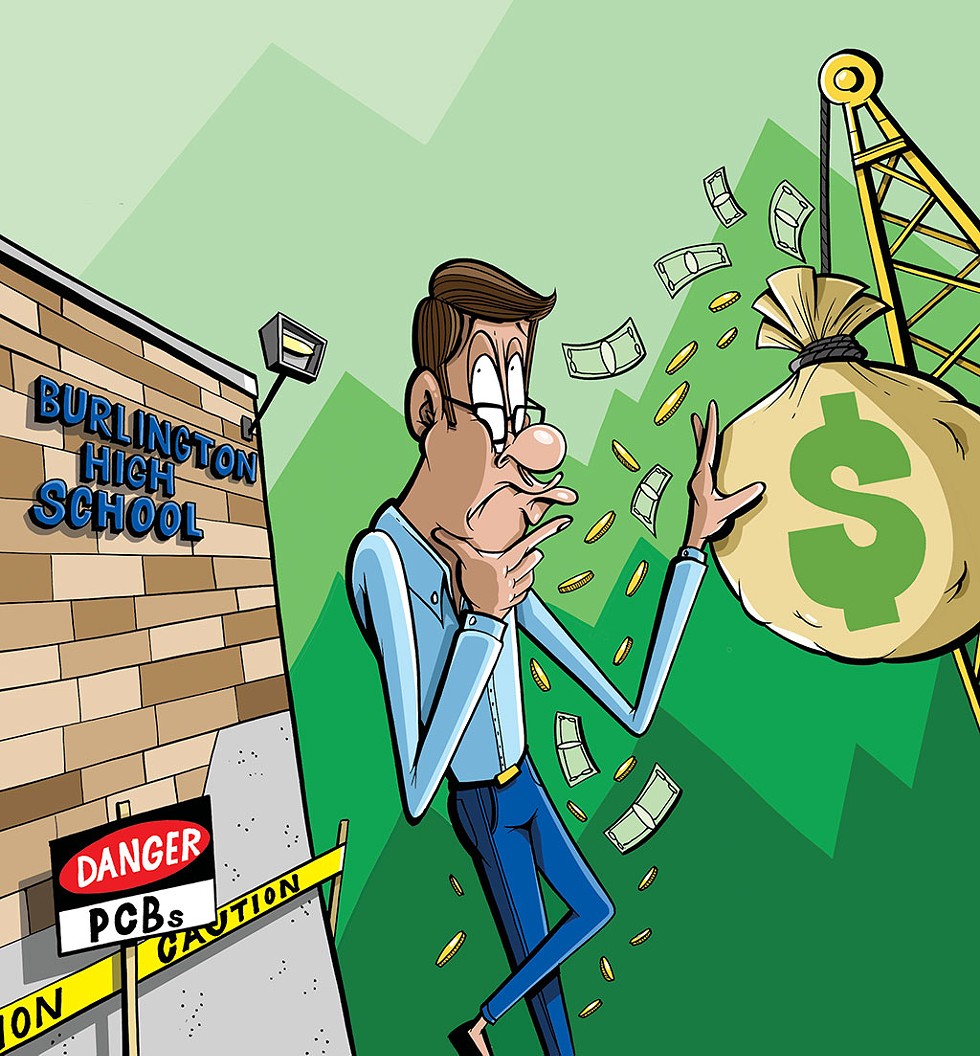
- Matt Mignanelli
On a cloudy Tuesday evening in early September, Liz Derry walked down Cross Parkway in Burlington as her two young kids rode their bikes up and down the street. Derry has lived in the modest New North End neighborhood for seven years, and her 5- and 8-year-olds attend nearby Flynn Elementary School.
Asked by a reporter if she would support a $165 million bond on November 8 to build a new high school, Derry said she hadn't followed the situation closely but unequivocally supports the project, even if it would raise her taxes.
"Whatever we have to do is OK with me. I'd rather just have them be in a good place," Derry said, gesturing to her kids.
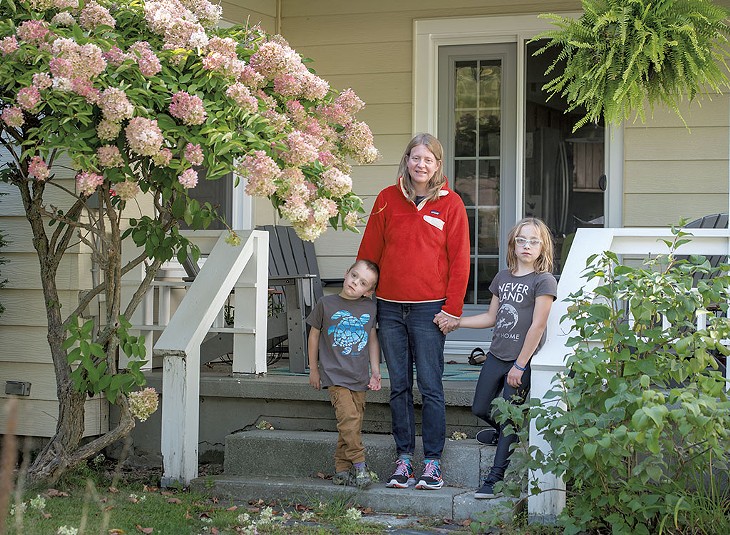
- Daria Bishop
- Liz Derry with her kids, Sawyer and Hazel
On the other side of the street, James Vincent, a longtime resident whose children recently graduated from Burlington High School, said he was still undecided.
"It just seems like the scope of the project and the cost is way, way, way out of whack with the size of our city and what we can shoulder," Vincent said. "I'm not convinced that's what's required."

- Daria Bishop
- James Vincent
Derry and Vincent are just two people on a single, dead-end street, but their responses reflect how city residents are weighing the choices they face. Over the past 20 years, Burlington voters have almost always agreed to tax increases for the city's schools. This time around, however, they find themselves in a tug-of-war between the desire to move high school students out of makeshift temporary quarters into a spacious, 21st-century school building — and the high cost of what would be the biggest school bond in Vermont history.
For nearly 1,000 Burlington high school students, failure of the bond would almost certainly mean more semesters in the former downtown department store where they now attend classes. They were moved to the windowless classrooms in March 2021, after elevated levels of airborne toxic chemicals known as polychlorinated biphenyls, or PCBs, were found on their Institute Road campus.
Related Burlington High School Opens Downtown Campus in Former Macy's

For many homeowners, passage of the bond would mean a substantial increase in their annual property taxes at a time when they are still smarting from last year's property reappraisal, which significantly raised their tax bills. Estimates released by the district show that a home assessed at $370,000 — close to the city's median assessed value — would pay an additional $805 a year in taxes, or about $67 more a month. Residents who pay based on their income could owe considerably less, but the district hasn't published many details.
And there's another worry. Burlington Mayor Miro Weinberger supports the proposed high school, and the city council voted unanimously last month to put the bond on the ballot. But Weinberger, who has spent years getting the city to a place of financial stability, is also concerned that the project could lower the city's credit rating and reduce its ability to pay for other municipal improvements in coming years.
School district officials have promised to seek state and federal grants and to conduct private fundraising to reduce the amount of debt homeowners would take on. Still, they concede, the bond amounts to a substantial ask.
"We are taxpayers ourselves, and so we're highly aware of the expense," school commissioner Kendra Sowers said.
In fact, one former school commissioner, David Kirk, said he will likely vote no — the price tag is simply too high, for one thing. A homeowner in the New North End, Kirk would pay about $700 more in annual school taxes if the bond passed. The increasing cost of gasoline and groceries is hard enough to stomach, Kirk said.
"We're in double-digit inflation times ... I mean, a box of Rice-a-Roni is up over 50 percent," he said. "[This bond] may drive me out of the city. We're contemplating that every day."
City Councilor Mark Barlow (I-North District), a former member of the school board, sees it differently. He'll vote yes on the bond, he said, because it's no mystery why some families have moved to places such as South Burlington.
"They have a high school, and we don't. We're in a department store," Barlow said. "In order to maintain Burlington's appeal ... we're gonna have to have a high school."
School district leaders say time is of the essence. They hope to begin demolition of the old buildings in late December or January and have the new school ready for students in the fall of 2025. Their plans call for a 250,000-square-foot, energy-efficient building with an airy, two-level common area for dining and gathering, a 750-seat tiered auditorium, a large community gym, and multiple outdoor classrooms and gathering spots.
Meanwhile, the prospect of building an expensive new school may have contributed to the defeat last December of the city's $40 million spending plan to fix up sidewalks and replace aging fire trucks. Voters approved a scaled-back $23.8 million bond in March — the same day the district announced that the new school would cost upwards of $160 million.
Related On Town Meeting Day, Burlington Voters Will Again Consider New City Spending — and a Tax Hike

Other districts have attempted to pass school bonds in recent years, with mixed results. In May 2019, a $58 million bond to support a campus-wide overhaul in Winooski was approved by a margin of just 22 votes. That project is scheduled to be completed later this fall. In 2020, South Burlington voters overwhelmingly rejected a $210 million bond to renovate the city's middle and high schools. And last November, residents of six towns resoundingly voted down a $60 million bond to renovate Harwood Union Middle & High School.
Burlington voters have only rejected a school budget twice in the past 20 years. State Sen. Phil Baruth (D/P-Chittenden), a former Burlington school commissioner, said the last time he saw a concerted effort to oppose school spending was in 2002, when a group put signs around town with a slogan bemoaning the expected tax hike.
There's no sign yet of organized public opposition to this bond, but voters are weighing the pros and cons in the privacy of their homes. Vincent, the undecided Cross Parkway resident, said he supports education, despite his reservations.
"I would vote yes for a raise for any teacher and any staff person in the school, every time, without question," Vincent said. "But this is a big step."
'A Broken Building'
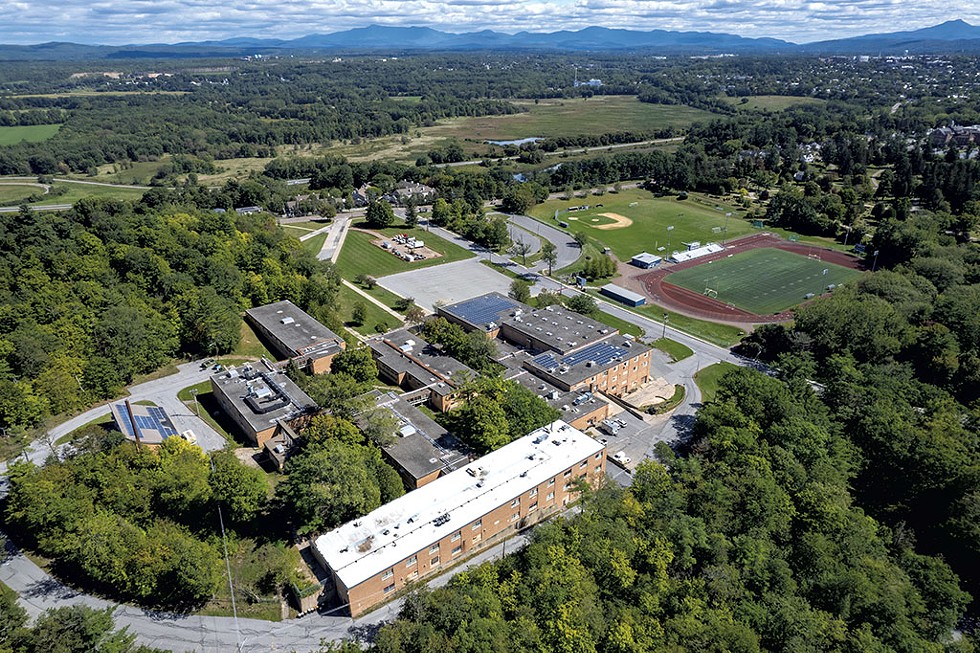
- James Buck
- Burlington High School
When the new Burlington High School opened its doors to students on Institute Road in the fall of 1964, the community hailed it as a beacon of modernity.
The sprawling New North End campus has since lost its luster. The maze of buildings and insufficient insulation have made heating and cooling difficult. Many of the mechanical systems and building materials are worn out, and the steep and uneven walkways don't comply with the Americans with Disabilities Act.
Four years ago, the school district sought to remedy those problems with a large renovation that would have consolidated the campus, modernized classrooms, updated mechanical systems and fixed accessibility problems. Burlington residents approved a $70 million bond in November 2018, with 74 percent in favor.
But in the summer of 2020, during the course of environmental testing before that renovation, PCBs were found on campus, spurring the district to shut down the building. Additional testing revealed the chemicals had spread into the ceiling, walls, concrete foundation and soil.
Key to getting voters' support for the bond, school officials believe, is making clear that the school had a multitude of problems even before PCBs were discovered. The chemicals were just a nail in the coffin.
During an August walk-through of the campus — a 254,000-square-foot network of six buildings connected by covered walkways — school leaders pointed out some of the trouble spots: windows with broken seals, clouded from humid air that had seeped between the panes; brackish water dripping from exposed ceiling pipes and collecting in a bucket; metal heating pipes on the roof, exposed to the elements, their insulation ripped apart by pigeons.
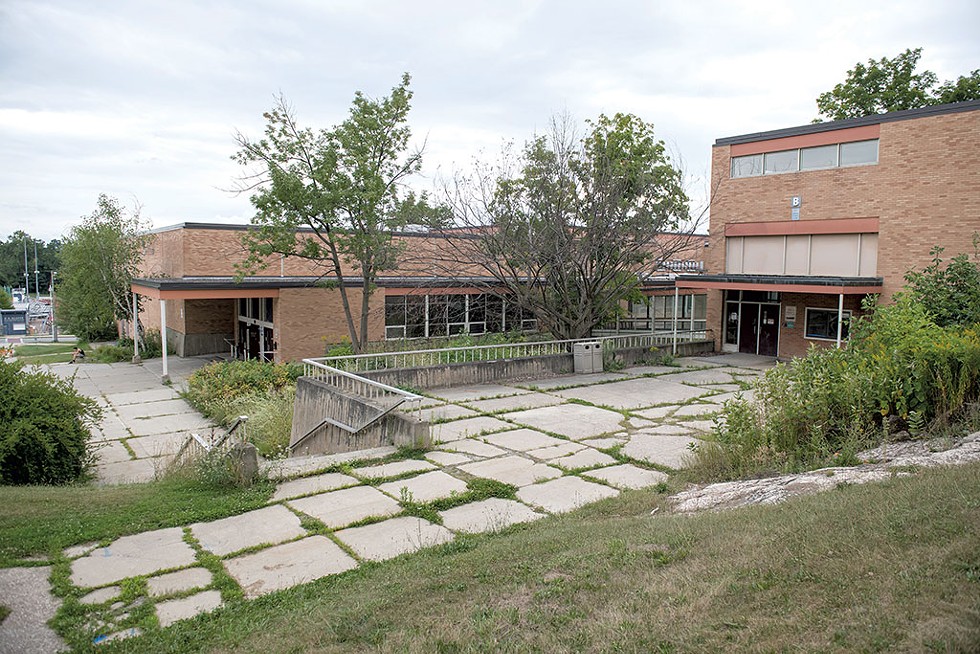
- Daria Bishop
- Burlington High School
The building has only continued to decay in the two years it's been unoccupied. Walkways are overrun with weeds; boarded-up library windows and piles of books accumulating dust give the building a postapocalyptic air. A dummy lay slumped over in a hallway, and blank bullet casings — remnants of a Burlington police active shooter drill — were scattered across the floor, adding to the eerie atmosphere.
During the tour, Burlington High School principal Lauren McBride recalled how students would prop open exterior doors to take shortcuts between buildings, creating safety issues. On hot and cold days, McBride would jam a blanket into her drafty office window. Peeking into her abandoned office, she saw that the blanket was still there.
In an interview with Seven Days, school board member Aquilas Lokossou, a 2018 BHS graduate, recalled the drastic temperature swings from one part of the building to another and how the covered walkways leaked when it rained. The layout "didn't support people who had a hard time getting around campus," he said.
Kate Stein's son Seamus learned firsthand how hard the campus was to navigate. A 2019 grad, Seamus has cerebral palsy and uses crutches to get around. To make it to physics class, he had to contend with three elevators, an outside path and several walkways. If an elevator were broken, he'd scramble to find someone to help him climb the stairs so he wouldn't be late to class.
"It sort of breaks your heart," said his mother, who now works in the high school's special education department. "Everyone should be able to get to their classroom." She will vote for the bond.
Kathlin Bibens, mom to three children in the district, is also convinced of the need for a new school. Her husband, a window installer, worked for years fixing glass in the old building.
"He'd come home and talk about how much work was needed and how often what he was doing was a Band-Aid," Bibens wrote in an email.
And that's to say nothing of the PCBs. The discovery of the chemicals in August 2020 spurred the Vermont Department of Health to recommend that students and staff vacate the building until more information could be collected.
Related Hazardous Air Forces Burlington High School to Close for Entire Semester
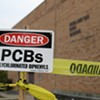
The district searched for a temporary space and eventually landed on the unoccupied former Macy's on Cherry Street. The state paid $3.5 million to transform the department store into a functioning school by March 2021.
In the meantime, the district continued testing to see how widespread the PCB contamination was. Reports from superintendent Tom Flanagan about the results read like a slow-moving train wreck.
In February 2021, he reported that high levels of PCBs were found in the glue under the flooring tiles in two buildings, requiring sampling of the concrete slabs underneath. The next month, Flanagan shared more bad news: PCBs had seeped as deep as three-quarters of an inch into those slabs. By April 2021, Flanagan said the planned renovation did not look feasible. To adhere to U.S. Environmental Protection Agency guidance, so many PCB-laden materials would have to be removed that little of the building would be salvageable.
In May 2021, the school board voted unanimously to start planning for a new high school.
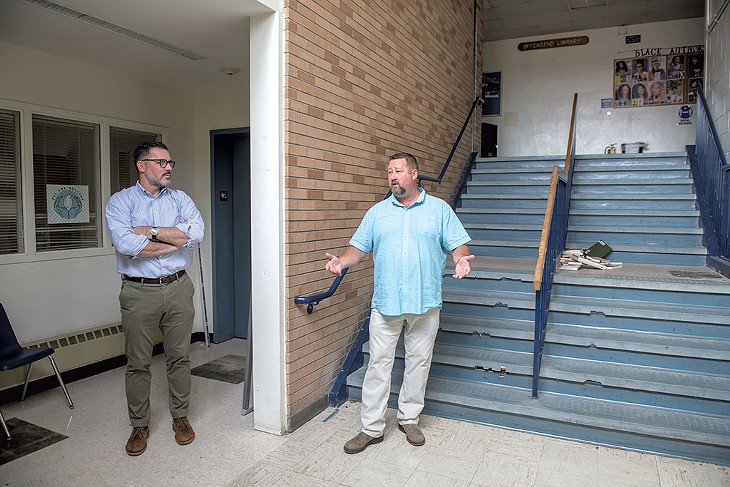
- Daria Bishop
- Superintendent Tom Flanagan (left) listening to Marty Spaulding of PCI Capital Project Consulting on a tour of BHS
After considering a number of sites, school officials ultimately decided the Institute Road campus was the best option, both financially and logistically. But they found a hurdle in their path later that month, when the Vermont Department of Health quietly loosened its guidance for acceptable airborne PCB levels in schools. Under the new guidance, 28 of the 40 rooms that were tested at Burlington High School fell below the state's new "action levels," which determine when schools need to identify and abate potential PCB sources inside their buildings.
Nevertheless, the district's leaders decided last December to stay the course because of the widespread contamination already found in the building materials. Even if those materials were removed, the district concluded, the school would be subject to ongoing and costly testing to ensure levels remained below the revised state thresholds.
The district estimates the new school will cost $190 million — $138.6 million for construction, $30 million for soft costs such as furnishings and design fees, and $21.4 million for demolition and remediation of PCB-laden materials and soil. The average cost per square foot would be about $538, which the district's architectural firm has said is in line with schools built in Massachusetts in recent years.
Yet officials will still need to win over residents who disagree with the need for a new high school. Peter Lorrain, who graduated from Burlington High School in 1975, lamented that voters aren't being given a choice to renovate the building and said he's a "no" on the bond. A former engineer, Lorrain suggested the district budget $30 million to remediate the PCBs and $30 million to address other deferred maintenance.
Asked how he came up with his estimate, Lorrain acknowledged, "That is probably more of a WAG: a wild-ass guess."
Mannie Lionni, a retired architect who has lived in Burlington since 1979, said he's not convinced that PCBs have harmed students and staff who have spent time in the building. He thinks that demolishing the school is a drastic and financially extravagant step.
"I'm 90 years old — my mind is pretty much made up," Lionni said. He also plans to vote no.
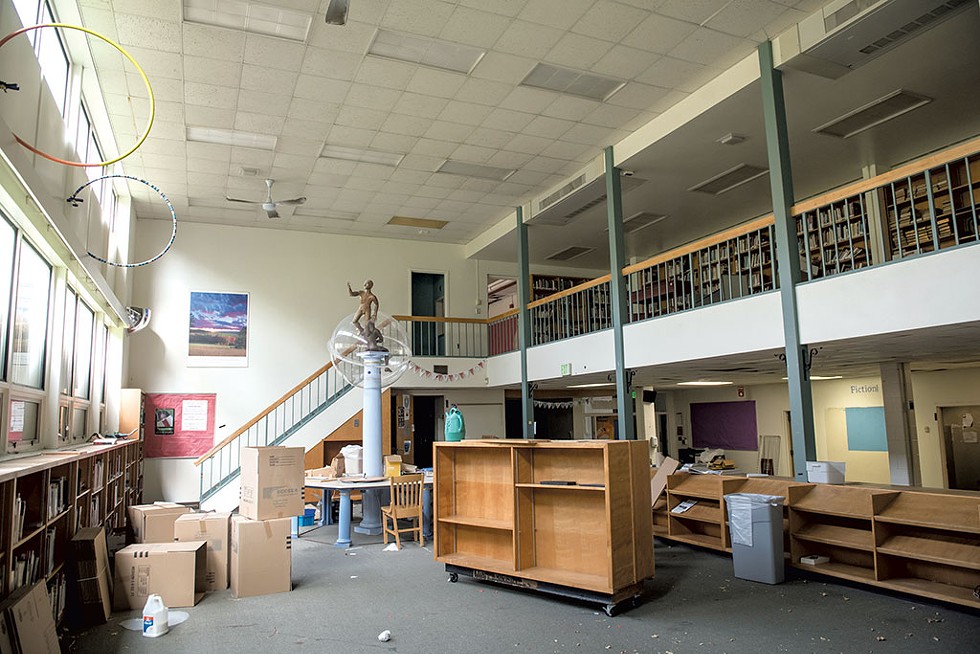
- Daria Bishop
- The BHS library
Understanding the scale of what they are asking residents to pay, school officials have worked to cut project costs. They've moved more than half of the technical center's programs off-site to shrink the building's footprint and are in talks with electric aviation company Beta Technologies to locate aerospace, automotive, advanced manufacturing and pre-tech programs in a wing of its new building at the Burlington International Airport. The school's two alternative programs, OnTop and Horizons, will remain at their current locations of Rock Point and St. Mark's Catholic Church, respectively. Officials have also identified $25 million for the project — $10 million in federal COVID-19 relief funds, $10 million from a previous bond allocation and $5 million from a budget surplus over the next five years.
Still, that leaves up to $165 million for taxpayers to fund through a 20-year bond with a 3.5 percent interest rate. Despite the scale of the project, both Flanagan and school commissioners remain steadfast in their belief that a new school is the right option.
"It's a broken building. It's 58 years old," school board chair Clare Wool said of the current campus. "We believe putting money into something that is new and free of contamination is money well spent, versus remediating something that is really not 100 percent remediable."
Voters' Dilemma
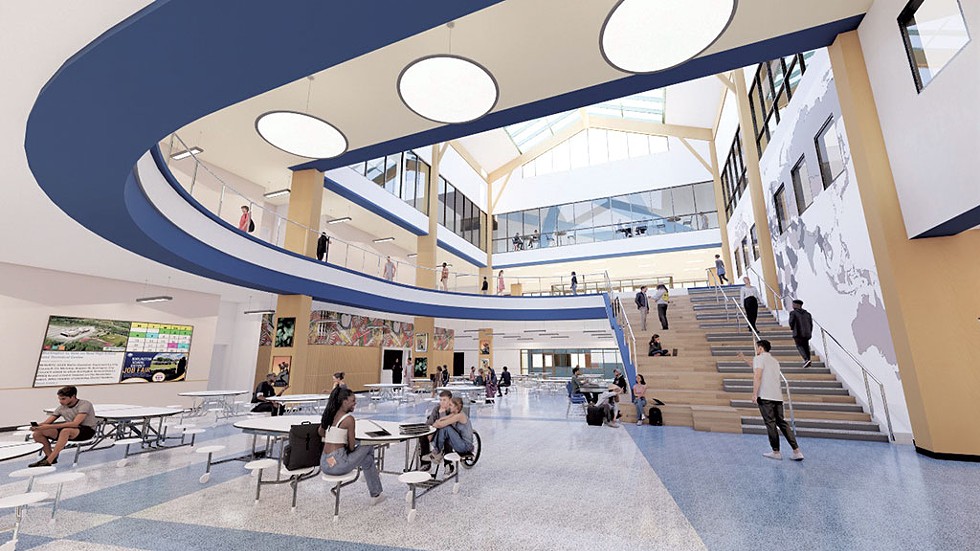
- Courtesy
- A rendering of the student commons
Christina Erickson likes the idea that her seventh grader may someday attend a brand-new high school, free of toxic chemicals. But after last year's reappraisal — which increased her taxes nearly 25 percent — she's also thinking about how it will affect her budget.
Erickson said her family could afford another increase, but she knows others can't, even if they support the school project.
"We vote for these things because we want them and don't really realize there's this implication that follows," Erickson said. "It's hard for me to really reconcile that because I think, We can make these things happen, and it will be great! And then I get my tax bill and I'm like, Wow, OK, that really kind of hurts."
Many voters are seeing the same conundrum. They want to support the school bond, and they don't want higher taxes — but they can't have one without the other.
The bond comes at a particularly tough time. Nearly 90 percent of single-family homeowners are paying higher taxes as a result of last year's reappraisal, which resulted in a 60 percent jump in median single-family home values.
Related Burlington's Property Reassessment Has Set Record-High Values. What's the Cost to Residents?

People with higher assessed values will pay more for the school bond. Add record-high inflation into the mix, and it's not hard to see why people are struggling with the question.
Sebastian Ryder and her husband, Jeff Bower, know the inadequacies of the school building firsthand. Bower has worked in the district's information technology department for 13 years, and Ryder, a former paraeducator, said cracked walls, missing tiles and broken fixtures were commonplace. But in her view, the district is asking for more than one of its own employees can afford.
Ryder, whom Seven Days interviewed last year about the reappraisal, said that process upped her household's monthly tax payments by about $200 — a significant amount considering she and Bower make $65,000 combined. The school bond could tighten the squeeze.
"If my personal impact is another $200 a month, I can't," Ryder said.
Related Tax Burdened: Residents Bear the Brunt of Burlington's First Property Reassessment in 16 Years

Ryder isn't the only one unsure of how the bond would affect their budget. The district has published detailed tax estimates for households making $140,000 or more but not for the more than 70 percent of Burlington households that make less. These "income-sensitized" taxpayers receive a tax discount because their incomes and home values fall within certain thresholds. They'd also pay less toward the school bond.
But the district has only provided one example for income-based taxpayers. A household with a $50,000 income and $370,000 home would owe $190 more in taxes per year, or about $15 per month, the district said.
Nathan Lavery, the school finance director, is working on a chart of tax estimates for other income-based payers and plans to share it at a town hall event on Wednesday, September 21, at the downtown high school. Several residents interviewed by Seven Days said they need to see those figures before deciding how to vote.
Others expressed concern that the bond is coming at a time when people are already struggling. Hill Section resident Steven Boutcher said he'll vote yes on the bond but fears that will make him complicit in exacerbating the city's affordability crisis.
"We need to keep things affordable, but the school bond measure, it just has to happen," Boutcher said. "It's an acknowledged conflict. I don't know how you get around it."
Boutcher is especially concerned that middle-income families, whom he called "the lifeblood of a city," will be driven out. Deena Frankel, a South End resident who was also featured in last year's reappraisal story, doesn't want Burlington to become an enclave for the wealthy.
Like Boutcher, Frankel said she both supports a new high school and could afford a tax increase, but she's concerned that the overall cost will create more wealth disparity in a city that already struggles with high housing costs and homelessness. Frankel, who doesn't have children, said she supports the schools and, as a Vermont master naturalist, has observed environmental education programs there. But she's leaning toward voting no on the bond.
"Unfortunately, what's probably a very meritorious proposal by the school board for a first-class, new high school is getting caught up with that incredible feeling of uncertainty ... of this moment," she said.
Fellow South Ender Robin Berger agrees. A parent to a senior, Berger wants to see a new high school built and will vote for the bond, but she fears that the cost could seal the bond's fate.
"I want the best for the children of Burlington because they are our future taxpayers, wage earners, citizens of this city," she said, but "Burlington housing is at such a crisis moment that I think it's going to make it a harder sell."
Berger also pointed out that the bond may spur landlords to raise their tenants' rents, a phenomenon that happened during the reappraisal. Several landlords Seven Days spoke with confirmed that when their taxes go up, so do the rents they charge.
Erickson, the mom of a seventh grader, has been discussing the bond with her neighbors in the Old North End, many of whom are just as conflicted about the choice ahead. Given such mixed opinions, Erickson said she has no clue if the bond will pass or fail. She said she'll vote yes.
"Even if it's not for my kid, [I hope] soon there will be an excellent high school that's in our community," she said. "How we get there, I can't predict at all."
To the Limit
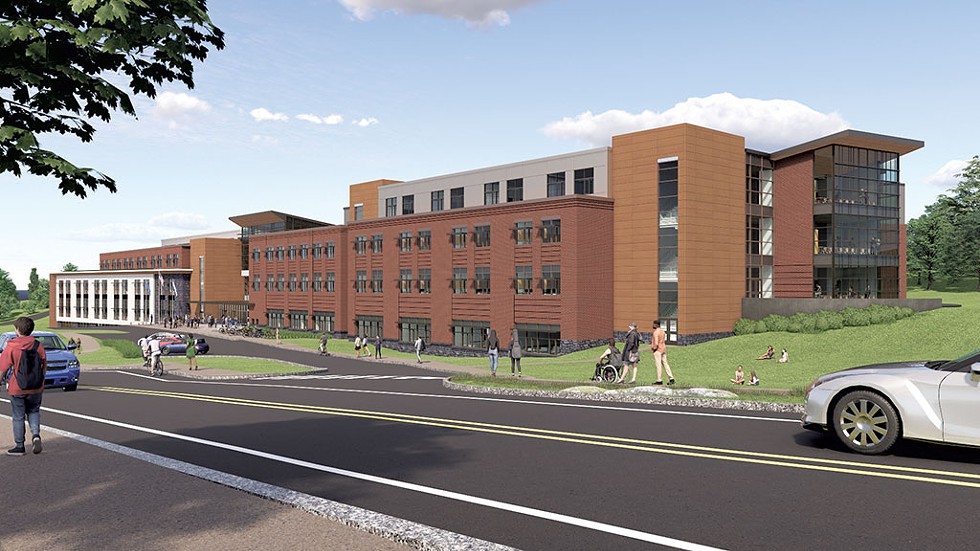
- Courtesy
- A rendering of the exterior
Mayor Weinberger, a parent of two Burlington students, supports the school bond. But he also recognizes what it means to approve it.
If the bond passes, the city would exceed its debt limit and put other large projects on hold. Such a move could also downgrade the city's premier Double A credit rating, a hallmark of Weinberger's decade-long tenure.
Weinberger thinks the trade-off is worth it, but others are questioning the wisdom of maxing out the city's credit card all at once.
"Schools are super important and maybe the first priority for a healthy community, but they're still not the only thing," Frankel, the South End resident, said. "If the city has other needs that would require bonding, how do we balance priorities in the future if there's no headroom?"
The crux of the issue is what creditors call overlapping debt. Although the city and school are separate entities, credit rating agencies consider their combined debt loads when assigning credit scores. Just as for home or car loans, the scores help determine a buyer's interest rate. (The city's moneymaking divisions, such as the water department, Burlington Electric and Burlington International Airport, are assigned their own credit scores, and their debt is calculated separately.)
The city and school measure overlapping debt in two ways. One metric says debt shouldn't represent more than 3.2 times the operating revenue; the other says debt shouldn't exceed 4.25 percent of the value of all taxable property in the city.
A $165 million school bond would clear the first hurdle but trip over the second. In fiscal year 2026, when the district has borrowed the full $165 million, the city and school would have a combined $291.7 million in debt, or just over 5 percent of the value of taxable property. That figure wouldn't drop below 4.25 percent until 2030.
"It is going to be a significant period of time," Weinberger said. "Barring unforeseen circumstances, we're not going to be able to [borrow] until approximately that period."
The school bond would have to be no more than $118 million to avoid exceeding the debt limit, city officials said. While Weinberger had hoped the bond would be no more than $150 million, he eventually agreed to the $165 million figure once the district promised to fundraise to defray the debt.
"This vision of Burlington as a place of opportunity, as a place where people of all backgrounds want to live, is threatened if we don't solve this," Weinberger said.
But passing the bond will still affect the city's plans, particularly for Memorial Auditorium, a former community space that closed in 2016 due to structural concerns. The city was preparing a $15 million bond in early 2020 to fix up the building, but the pandemic shelved those plans. The mayor and city council want to save the structure, but there's no money to do it.
Related Burlington Council Wants to Save Memorial Auditorium — But Next Steps Unclear
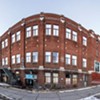
No city money, anyway. Next month, officials will begin a search for a partner organization that can help restore the building, Weinberger said.
There are other projects waiting in the wings. In 2019, the Fletcher Free Library proposed a $19.8 million renovation to add more meeting spaces, an indoor café and an outdoor terrace. But without city money, the library must seek philanthropic support or make small improvements over time. The city has also been discussing consolidating two fire stations into one new facility in the South End, though Weinberger said that plan — which could cost up to $30 million — is years away, regardless of the high school decision.
And there are other expensive and important issues, South End resident Frankel said, such as the housing shortage and creating a sustainable public transportation system. She also questions how the borrowing will affect the city's credit rating, which was near junk bond status a decade ago after Weinberger's predecessor, Bob Kiss, diverted city funds to save the struggling Burlington Telecom. Since then, Weinberger has raised the city's credit score six steps, saving millions of dollars in interest payments on city and school loans.
"Isn't [that] one of the big things he bragged about in seeking reelection?" Frankel asked.
Weinberger acknowledged that he's not entirely sure how the city's credit rating will fare but said he's optimistic, at least in the short term: The latest report from Moody's Investors Service gave the city a good fiscal outlook despite the impending school bond.
"They didn't downgrade us or signal alarm over that," Weinberger said. "The way I read the report, I think there's some reason to be hopeful, at least as long as things don't worsen further."
At the same time, even one downgrade would have a measurable impact. Katherine Schad, the city's chief administrative officer, estimates that taxpayers would owe nearly $2.4 million more in debt service over the bond's lifespan, or about $118,800 a year, if the city's rating dropped from its current Aa3 to A1.
"It's not like we're talking about the difference between raising your taxes $200 a month versus $2,000," Schad said. "But over a 15-year bond, even if it's only an extra $15 a month for a household, you think about people on the edge: $15 times 12 [months] times 15 years — it starts to add up."
Weinberger said voters will need to weigh the potential for more taxes against the risk that more families will leave if Burlington doesn't have a functioning high school.
In that case, "something very deep about the community would be lost," he said.
Selling It
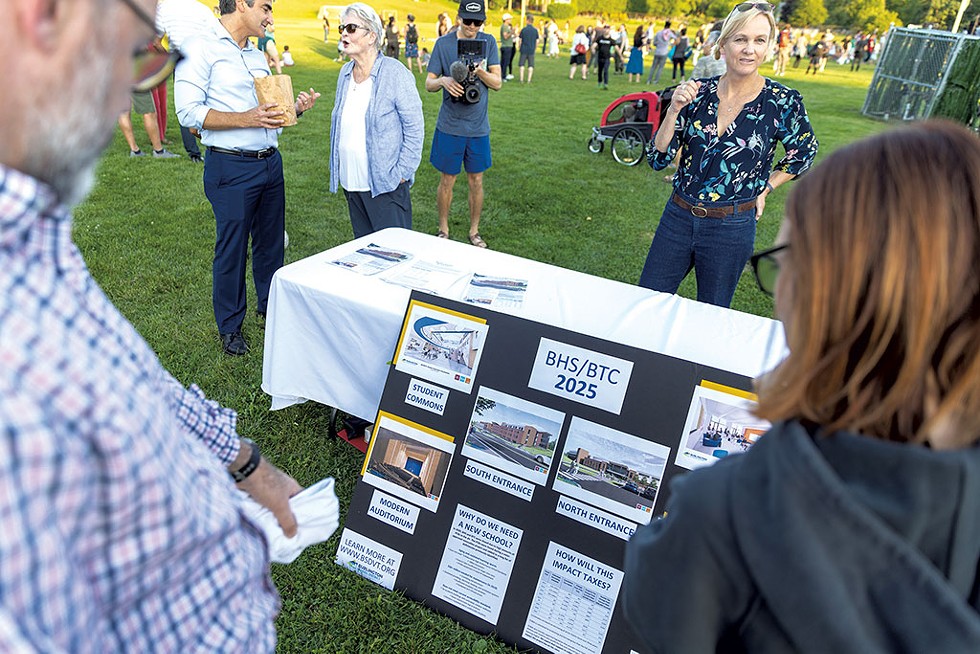
- James Buck
- Burlington school and city officials speaking with residents about the project
On a sunny Thursday evening, hundreds of Burlingtonians flocked to Institute Road's D.G. Weaver Athletic Complex for a back-to-school concert sponsored by the Flynn. As a high school soccer game wrapped up, the multigenerational crowd — parents leading their preschoolers by the hand, teens roaming in small packs, older folks in camp chairs — grooved to the music, then watched a trio of larger-than-life, luminous bird puppets move jerkily through the space.
The mayor, police chief and school superintendent were all there, surveying the scene and chatting up constituents. School commissioners had set up a display with information about the school bond. It was the kind of gathering that made the campus feel like a real community hub, except for one thing: an uninhabitable high school looming in the background.
The district is hoping such events can drum up support for the bond. With mail-in ballots for the general election going out in less than a week, officials are pitching the project with a clear message: The district is doing everything possible to avoid borrowing the full $165 million, from courting private donors to asking the state for money. How successful they'll be remains an open question.
Some years ago, Burlington would have been in a good position to get state dollars. The Agency of Education paid 30 percent of school construction costs but stopped the practice in 2007 due to a backlog of projects. Today, Vermont is the only state in New England with no designated money going directly to school construction. Massachusetts, for example, has invested $16 billion in school buildings since 2004, using a portion of the state's sales tax.
Vermont school officials have for years asked for the state's help to fix aging buildings, many of which were built in the 1960s and 1970s. They scored an infinitesimal victory in 2021, when the legislature passed a bill to assess the cost of various school improvements and potential funding sources, but legislators said the moratorium is likely to continue, at least for a while. Vermont Education Secretary Dan French said funding a construction aid program would be "challenging at this point in time" but believes that updated facilities are an important part of providing a quality education.
Knowing construction aid has dried up, Burlington officials have started a fundraising campaign in partnership with the Burlington Students Foundation, a nonprofit started in 1996 for community members to make tax-deductible donations for school projects. In the past, money has been used to fund college scholarships, performing arts programs and library materials. Superintendent Flanagan told city councilors last week that the district had so far raised about $50,000 from private donors. Putting a generous contributor's name on a new gym or auditorium is not out of the question, board chair Wool said.
Finance director Lavery said the district is researching and, in some cases, beginning to pursue around 16 federal and state grants. The bulk of those programs would provide money for narrowly tailored initiatives such as energy efficiency, stormwater infrastructure, outdoor classrooms and workforce development.
Finding outside funding is "about being creative," Lavery said.
But some city officials are still looking to the state to help solve Burlington's problem. Councilor Barlow, one of the more fiscally conservative members of the body, said Burlingtonians shouldn't have to shoulder the entire remediation cost, since the state changed its thresholds for acceptable PCB levels midstream.
"Part of this is on the state for having essentially kicked us out of the building," Barlow said.
Barlow is confident Burlington will win state support. For one, he said, the legislature has already set aside $32 million for PCB testing and remediation in Vermont schools. And he hopes that Gov. Phil Scott's support for workforce development will translate to funds for the tech center, which serves students across the region.
"I think the legislature recognizes that this is bigger than Burlington," Barlow said.
But that very point could work against the Queen City. After Burlington's PCB discovery, the state required all schools built or renovated before 1980 — when PCBs were banned — to test indoor air for the chemicals before July 2026. The process, which began this spring, has already identified PCBs in two schools: Brattleboro's Oak Grove and Cabot School. The latter school closed its gymnasium in late August after the discovery.
Because other schools are likely to need PCB money, it's unclear how much the state would give to Burlington.
Sen. Ann Cummings (D-Washington), a former chair of the chamber's Education Committee, said it's too soon to say where the money will go. Burlington may be an outlier, "or we could turn out to have 10 Burlington High Schools," Cummings said. "I think that's what we're waiting for, to find out the scope of the problem."
Mayor Weinberger isn't losing faith and said lobbying for state money will be the city's "top priority" in the upcoming legislative session. He also said he'd consider approaching private donors or using his political action committee, Partnership for Burlington's Future, to advocate for "yes" votes. The mayor has previously used PAC funds for mailers and online advertising encouraging voters to approve a city budget, agree to permit reform and expand the city's downtown improvement district.
At the same time, Weinberger made clear that the project, and its eventual cost, is in the district's hands.
"I'm committed to it. I'm gonna do everything I can," he said, but "I think it's a school district project. They've got to lead that effort."
School commissioners said they're up for that challenge but also stress that the approval of the bond is important for the entire city.
"What's going to happen to Burlington if we don't have a high school?" school commissioner Sowers asked. "Will families want to move here?"
School officials are hesitant to discuss a plan B — or what would happen if the bond doesn't pass. The district would "have to regroup and be on the ballot again in March," Sowers said.
"But we want to live in a city that ... has a great high school, and we need to ensure that we have that for the next generation," she continued. "We would like to stick with plan A."
Back at the concert, school board members tried to make their case to voters as the sun went down over the Queen City. Mike Healey, who moved with his wife to the New North End in May after raising their now-adult children in Kentucky, was easily won over. Healey said he'll support the bond because when his kids were growing up, people before them had helped fund their schools. The way Healey sees it, supporting this project is a way to "pay it forward," he said.
Nearby, dozens of young kids squealed with glee as they chased the towering bird puppets across the grass, trying to pet their beaks and gazing up into their glowing eyes. One day, not too long from now, those kids will start high school. Burlington voters will ultimately decide just what kind of school it will be.














Comments
Comments are closed.
From 2014-2020, Seven Days allowed readers to comment on all stories posted on our website. While we've appreciated the suggestions and insights, right now Seven Days is prioritizing our core mission — producing high-quality, responsible local journalism — over moderating online debates between readers.
To criticize, correct or praise our reporting, please send us a letter to the editor or send us a tip. We’ll check it out and report the results.
Online comments may return when we have better tech tools for managing them. Thanks for reading.